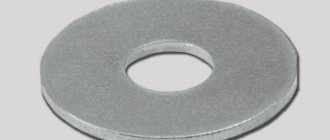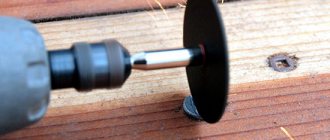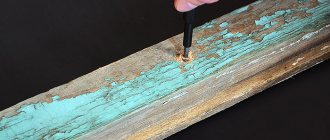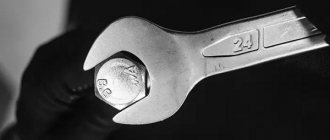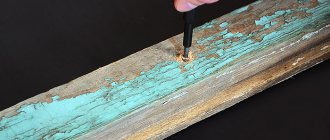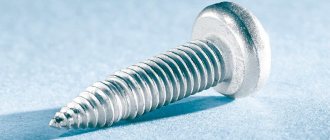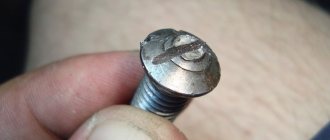Article reading time: 20 minutes
Author of the article:
Screwing a shelf, hanging a lantern, connecting metal profile elements, fixing a window frame inside an opening - in all of the above cases, the correct fasteners are needed. The variety of fasteners on the construction market is enormous. Sometimes it is difficult for a person without experience to choose what type of products is needed to perform a specific task. The most common are screws and bolts. Next, we will look at what is the difference between a screw and a bolt, what are the similarities between these types of parts, where they are used and what they are.
Basic concept of a screw
The definition of “screw” comes from the German word “gewinde”, meaning “threading” or “threading”.
Designed to connect two or more parts, this product consists of a round leg with an external thread and a cap at its end.
The leg is intended for fixing parts, and the cap is intended for mounting it. Depending on the method of application, fasteners are divided into bolts and screws. We can conditionally consider a screw to be a small bolt and they will differ from each other in that the second has a hexagon-shaped head, and the first has different head designs.
Comparison
So, a screw differs from a bolt in the method of connection.
A screw and a bolt are used in different loading patterns. The calculation of the bolt is based on shear (a large load falls on the place perpendicular to the parts being connected). The calculation of the screw is based on non-opening of the joint (the main load falls on the place located along or parallel to the axis of the parts being fastened). The design of a screw is very similar to a bolt. However, their main difference lies in the application: the bolt passes through the parts to be connected, a nut is screwed onto it, and a screw is screwed into one of the parts to be connected that has a thread using a screwdriver.
The screw can be tightened or unscrewed using a screwdriver or socket wrench inserted into the slot in its head. The bolt is tightened with a wrench or nut. That's why the heads have different slots. A bolt cannot rotate as a result of connecting two parts, like some types of screws used in moving, moving machine mechanisms.
When screwed in, the head of the screw is often deepened into the part being connected, while in a bolted connection it remains on the surface. The very concept of a screw, as a geometric figure, corresponds to the word “thread”. For the sake of example, we can cite the lead screw in the familiar jack and lathe. Bolt means “rod”. Screws, unlike bolts, are often made very small. For example, screws are common for fastening watch movements and other micro-sized devices. A bolted connection is disconnected by cutting off the bolt, and a screw connection is disconnected by cutting off the screw thread.
What does the screw head look like?
Depending on the application location and the tool used for installation, the screw head may have different shapes. The most common head screws are:
- Cylinder. Designed for installation using a hex wrench.
- Hemisphere. Has slots for a screwdriver. They can have a full cross-section for a slotted screwdriver, an incomplete cross-section for a Phillips screwdriver, and also a combined cross-section for both types of screwdrivers.
- Frustum. Designed for hidden installation “flush” with the part being fixed. Installation can be carried out using either screwdrivers or a hex wrench.
Pan head screw
Hemisphere head
It seems that now it becomes clear that if the head is not under the socket or open-end wrench, then this fastener is a screw. However, large screws can also have a hex head. In this case, the whole point of comparing these hardware products only due to the size and shape of the cap is lost.
In order to understand exactly how one fastener differs from another, let’s try to refer to GOST 17473-80, it clearly states what characteristics both types of fasteners should have.
Download GOST 17473-80
Bolts and screws according to GOST. What is the difference? Similarities and differences
| Catalog / bolt, GOST screw, sale of bolts |
The question of the difference between a screw and a bolt is often raised on the Internet both among specialists and complete amateurs in this field. But a definite answer has not been given even today. Let’s try to do an analysis and still find these “elusive” differences between a screw and a bolt.
Interstate standard GOST 27017-86 “Fastening products. Terms and Definitions”, GOST 7798, which should bring complete clarity to this issue, unfortunately does not. According to the standard, a bolt is a fastener consisting of a rod and a head, which forms a connection using a nut or hole in one of the parts being fastened. According to the same standard, a screw is a fastener for creating a connection, including a rod and a structural element for transmitting torque. Separately, the note emphasizes that this structural element can be a head with a slot, knurled, or, in the absence of a head, a slot in the end of the rod. The Great Soviet Encyclopedia (site https://dic.academic.ru/) gives an even more vague concept of a bolt. According to it, a bolt is a fastener with a thread on one end and a four- or hexagonal head on the other. The concept of “screw” is also interestingly interpreted in the Russian version of Wikipedia. According to it, this is a fastener for connecting parts, one of which has an internal thread or without it.
Let's collect all the above interpretations and try to find a significant difference between these two types of fasteners
The main thing you need to pay attention to is: is a nut used in the fastening connection, what shape of the head is used to transmit torque
Range of sizes of bolts, screws: M6 bolt, M8 bolt, M10 bolt, M12 bolt, M16 bolt, M20 bolt, M24 bolt, M27 bolt, M30 bolt, M36 bolt, M42 bolt, M48 bolt, M52 bolt.
If we proceed from the GOST definitions, then the counter fastener for a nut (regardless of the shape of the head) will always be a bolt. The fastener with a hex head connecting parts, if one or both have internal threads, is a bolt. The same thing, but without an internal thread in the part and not with a hex head - it's a screw.
Many experts in the mechanical engineering industry are inclined to believe that a screw, a stud and a bolt are determined by the corresponding fastener. A fastener with a male thread and a head plus a nut is a bolt. The same product plus a part is a screw.
But there is still no complete clarity on this issue. If the threaded connection includes a nut and a fastener with an external thread and a countersunk head with a Phillips slot. Is the fastener a screw or a bolt?
Yes, there are questions for the standardization bodies.
How to buy bolts and screws according to GOST at low prices:
- fill out the simple “Place an order” form at the top of the page;
- call +7;
- send your application by email;
Terms of sale:
- Sales of metal products wholesale and retail;
- Cashless payment by transferring funds from a bank account;
- Possibility of deferred payments;
- Free consultations from our specialists;
- We provide packaging services according to customer requirements;
- We are ready to produce products of any complexity to order according to customer drawings.
Delivery terms:
- Products are delivered from the warehouse based on availability;
- If necessary, we can provide a storage service;
- We are ready to provide a discount on delivery according to the terms of partnership programs of transport companies;
- Possibility of self-pickup of goods from warehouses.
Guarantees:
- All products are certified and released after technological control;
- Hardware, fasteners, ropes, mesh, wire, electrodes and other metal products comply with GOST and TU;
- Possibility of returning goods in accordance with the legislation of the Russian Federation;
Delivery within the Russian Federation: Moscow, St. Petersburg, Arkhangelsk, Astrakhan, Barnaul, Belgorod, Bryansk, Vladimir, Volgograd, Vologda, Voronezh, Yekaterinburg, Ivanovo, Izhevsk, Yoshkar-Ola, Kazan, Kaluga, Kirov, Kostroma, Krasnodar, Kurgan, Kursk, Lipetsk, Omsk, Orenburg, Penza, Perm, Pskov, Rostov-on-Don, Ryazan, Samara, Saransk, Saratov, Sevastopol, Simferopol, Smolensk, Stavropol, Tambov, Tver, Tomsk, Tula, Tyumen, Ulyanovsk, Ufa, Chelyabinsk, Yaroslavl, etc.
The information presented on this website contains a catalog of reference information on more than 3,000 types of metal products, is for informational purposes only, and can be used in various areas of enterprise activity.
Bolt as the basis for product safety and service life
Bolted connections are used in load-bearing structures of buildings, bridges and other structures. For safe operation and long service life, the size of fasteners and their strength used in connection are calculated based on the load that will be applied to the mating parts. The type of load is also taken into account: shear or compression. All these characteristics are described by GOST, so using it, you can try to define what a bolt is.
Bolted connection
According to GOST, it is a fastener made in the form of a rod and having a head at one end and an external thread at the other.
Using a nut or threaded hole in one of the parts being connected, it forms a rigid connection that is resistant to shear. This description is no different from the description of the screw, so you should take a closer look. But it’s worth making one small digression, it will still be needed. The key phrase is “shear-resistant,” let’s remember it.
What is the difference between a nut and a bolt: comparison, photo
A nut differs from a bolt in that they are two fasteners that are used in pairs. That is, the nut has an internal thread, and the bolt has an external thread. Accordingly, the nut is screwed onto the bolt. In this way, the structural elements are connected.
Bolt
screw
Bolt in detail
Outwardly, it is very similar to a screw; it also has a thread and a head. However, if you take a closer look, you can see how they differ.
Products connected by a bolt must be rigidly secured against shear, so it is placed in a calibrated hole and should not rotate.
Let us remember the definition given by the guest earlier, this is where it came in handy for us. To prevent the products from shifting, there is a calibrated thickening on the leg below the head and above the thread. It becomes obvious that if there is a thickening on the fastener below the head, then it is a bolt. But is this the only difference between both fasteners?
Types of heads
Screw addicts: signs of screw use
A person using a Screw can be identified by the following characteristics:
- excessive activity
- loss of appetite and hunger,
- rapid pulse,
- prolonged insomnia,
- convulsive states,
- nausea,
- delusional states and hallucinations,
- sudden changes in mood, aggressiveness followed by indifference,
- anxiety, suicidal tendencies when discontinuing the drug.
Some may experience obsessive-compulsive disorder, losing the sense of time: a person “freezes” in one position or becomes fixated on performing one action for a long time.
DRUG ADDICTION TREATMENT in MOSCOW
Classification of bolts depending on the application
The connected products must be securely fixed and resistant to shear. Therefore, depending on the scope of application, fasteners can be distinguished:
- Chernova. It is made of high-carbon steel by stamping and is not machined. It is used in non-critical units where there is no heavy load.
- Finishing. Manufactured from alloy steel using full machining. Used in highly loaded, critical units.
- Semi-clean. It differs from finishing ones in that the head is stamped in accordance with GOST, but is not processed. The most common type, used in most cases.
Treatment prices:
| Service | Price, rub) |
| Types of therapies | |
| Standard detoxification therapy | 3 500 ₽ |
| Double Detox Therapy | 6 000 ₽ |
| Enhanced Detoxification Therapy | 7 500 ₽ |
| Maximum detoxification therapy | 9 500 ₽ |
| Quick sobering up at home | 7 500 ₽ |
| Hospital at home 1 day | 22 000 ₽ |
| Advanced hospitalization | 15 000 ₽ |
| Treatment in hospital | |
| Accommodation | |
| Economy chamber (6 beds) | 2 000 ₽ |
| Standard room (4 beds) | 3 000 ₽ |
| Increased comfort (2 seater) | 5 500 ₽ |
| VIP chamber (1 person) | 12 500 ₽ |
| Individual post 24/7 | 5 000 ₽ |
| Medical and social rehabilitation 21 days | 140 000 ₽ |
| Service | Price, rub) |
| Initial consultation with a narcologist | for free |
| Consultation with a psychologist | 3 000 ₽ |
| Psychiatrist consultation | 5 000 ₽ |
| Coding at home Torpedo | 7 500 ₽ |
| Express output and encoding (doublet) | 13 500 ₽ |
| Coding using the Dovzhenko method | 12 000 ₽ |
| Hypnosis classic session | 13 000 ₽ |
| Ericksonian hypnosis session (NLP) | 8 000 ₽ |
| Coding method Torpedo | 5 500 ₽ |
| Double block | 8 000 ₽ |
| Esperal injection for 1 year | 9 900 ₽ |
| Tetlong for 3 months | 10 500 ₽ |
| Esperal gel for 1 year | 15 000 ₽ |
| Selincro course of therapy | 12 500 ₽ |
| Implantation of Disulfiram for 1 year | 18 000 ₽ |
| Vivitrol injection for 1 month | 26 000 ₽ |
| Naltrexone stitching for 3 months | 35 000 ₽ |
| Neuroimplantation Prodetoxon for 6 months | 47 500 ₽ |
| Narcopsychotherapy session | 50 000 ₽ |
| Neutralization of encoding | specify |
| Psychodiagnostics / pathological diagnostics | 7 500 ₽ |
| Psychotherapy session | 5 000 ₽ |
| Family psychotherapy | 6 000 ₽ |
| Outpatient rehabilitation in Moscow | 33 000 ₽ |
Expand
After discharge from the clinic, the addict is sent to a rehabilitation center. There he regains his lost social skills and re-learns to experience the joy of a full and sober life. Like salt addicts, those who use vint require long-term rehabilitation. On average, to get rid of addiction, a drug addict spends about two years in the center.
Leave a request for a free consultation with a specialist
We will contact you as soon as possible
- — Anonymous
- - For free
- — Around the clock
Article prepared by an expert
Terekhova Anna Vladimirovna
psychologist-consultant on socio-psychological work with addicted clients and their families. More than 9 years of experience.
Similar articles:
Smoking mixtures
Marijuana: effect, signs of use and consequences
What is LAUGHING GAS?
What to do if drug coding does not help?
Hashish: effect, signs of use and consequences
Bolt Application
The bolt not only compresses the mating parts, but also prevents them from moving. Therefore, before connecting, it is necessary to drill a special calibrated hole in them, equal in diameter to the thickening on the bolt leg. For example, for M10 fasteners, the hole must be exactly 10 mm; if the diameter of the hole differs, the parts will not be securely fastened against shifting. A washer is placed on the threaded shank, then the connection is secured with a nut. If the connection point is subject to vibration, then an additional lock washer is used to prevent the nut from being unscrewed without permission.
The use of bolts in car repairs
Strength classification
Depending on the purpose, there are 11 different strength classes of fasteners. They are marked as 3.6, 5.8, 12.9, where the first numerical value is the tensile strength divided by 100, and the second is the quotient of the yield strength and tensile strength divided by 10. That is, the first number characterizes the tensile strength, the greater it is – the greater the load the fastener can withstand. And the second shows how much it will stretch under load. High-strength fasteners are used in critical components of equipment or in the construction of bridges.
Bolt strength class
For reliable fixation, the tightening torque of the bolts is additionally taken into account. It should not exceed permissible limits, otherwise the steel begins to stretch and at the most inopportune moment the connection may burst. This will lead to dire consequences.
Definition
Screw
- This is a rod with a head and a sharp thread. Fasteners are used when it is necessary to attach a part to some soft material. For example, when it comes to screwing into wooden or plastic products. The classification of screws can be different: there are products for wood and metal, and the fastening element can also be divided according to the shape of the head. Today, a screw can have a hexagonal, countersunk, square or semicircular head. It all depends on what the screw is used for and what product it is attached to. Compared to a self-tapping screw, it has both its certain advantages and some disadvantages.
Screw
Self-tapping screw
- This is a screw with a sharp thread. The product has either a sharp tip or a drill tip, depending on what kind of work is being done. The main characteristic feature of self-tapping screws is that the triangular thread completely covers the cylindrical surface. For example, screws or screws do not have this feature. Today, self-tapping screws are made from various materials, including carbon and stainless steel, plus the coating itself can be different. All these factors have a direct impact on the cost of the fastener, which varies greatly. Separately, it is worth highlighting the purpose of self-tapping screws - they are used for a variety of purposes: for fastening wood parts, drywall, sheet material, metal profiles.
Self-tapping screw
Bolt shapes
Bolts can also have different head shapes. Most commonly used forms:
- Folding. Used in rigging work, they have an eyelet that allows you to secure a cable or rope.
- Anchor. For fastening into a blind hole in materials where it is not possible to cut a thread. For example, in concrete walls.
- Eye bolts. Similar to folding ones, they are also used in rigging work.
- With hex head. The most common.
- Secret. The head is made in the form of a truncated cone and does not protrude above the attachment point.
- With cylindrical head. A hex wrench is used for installation and dismantling.
- With a semicircular hat. Small size with a groove for a slotted or Phillips screwdriver.
Countersunk bolt
anchor bolt
Eye bolt
Download GOST 7798-70
Bolts and screws according to GOST. What is the difference? Similarities and differences
| Catalog / bolt, GOST screw, sale of bolts |
The question of the difference between a screw and a bolt is often raised on the Internet both among specialists and complete amateurs in this field. But a definite answer has not been given even today. Let’s try to do an analysis and still find these “elusive” differences between a screw and a bolt.
Interstate standard GOST 27017-86 “Fastening products. Terms and Definitions”, GOST 7798, which should bring complete clarity to this issue, unfortunately does not. According to the standard, a bolt is a fastener consisting of a rod and a head, which forms a connection using a nut or hole in one of the parts being fastened. According to the same standard, a screw is a fastener for creating a connection, including a rod and a structural element for transmitting torque. Separately, the note emphasizes that this structural element can be a head with a slot, knurled, or, in the absence of a head, a slot in the end of the rod. The Great Soviet Encyclopedia (site https://dic.academic.ru/) gives an even more vague concept of a bolt. According to it, a bolt is a fastener with a thread on one end and a four- or hexagonal head on the other. The concept of “screw” is also interestingly interpreted in the Russian version of Wikipedia. According to it, this is a fastener for connecting parts, one of which has an internal thread or without it.
Let's collect all the above interpretations and try to find a significant difference between these two types of fasteners
The main thing you need to pay attention to is: is a nut used in the fastening connection, what shape of the head is used to transmit torque
Range of sizes of bolts, screws: M6 bolt, M8 bolt, M10 bolt, M12 bolt, M16 bolt, M20 bolt, M24 bolt, M27 bolt, M30 bolt, M36 bolt, M42 bolt, M48 bolt, M52 bolt.
If we proceed from the GOST definitions, then the counter fastener for a nut (regardless of the shape of the head) will always be a bolt. The fastener with a hex head connecting parts, if one or both have internal threads, is a bolt. The same thing, but without an internal thread in the part and not with a hex head - it's a screw.
Many experts in the mechanical engineering industry are inclined to believe that a screw, a stud and a bolt are determined by the corresponding fastener. A fastener with a male thread and a head plus a nut is a bolt. The same product plus a part is a screw.
But there is still no complete clarity on this issue. If the threaded connection includes a nut and a fastener with an external thread and a countersunk head with a Phillips slot. Is the fastener a screw or a bolt?
Yes, there are questions for the standardization bodies.
How to buy bolts and screws according to GOST at low prices:
- fill out the simple “Place an order” form at the top of the page;
- call +7;
- send your application by email;
Terms of sale:
- Sales of metal products wholesale and retail;
- Cashless payment by transferring funds from a bank account;
- Possibility of deferred payments;
- Free consultations from our specialists;
- We provide packaging services according to customer requirements;
- We are ready to produce products of any complexity to order according to customer drawings.
Delivery terms:
- Products are delivered from the warehouse based on availability;
- If necessary, we can provide a storage service;
- We are ready to provide a discount on delivery according to the terms of partnership programs of transport companies;
- Possibility of self-pickup of goods from warehouses.
Guarantees:
- All products are certified and released after technological control;
- Hardware, fasteners, ropes, mesh, wire, electrodes and other metal products comply with GOST and TU;
- Possibility of returning goods in accordance with the legislation of the Russian Federation;
Delivery within the Russian Federation: Moscow, St. Petersburg, Arkhangelsk, Astrakhan, Barnaul, Belgorod, Bryansk, Vladimir, Volgograd, Vologda, Voronezh, Yekaterinburg, Ivanovo, Izhevsk, Yoshkar-Ola, Kazan, Kaluga, Kirov, Kostroma, Krasnodar, Kurgan, Kursk, Lipetsk, Omsk, Orenburg, Penza, Perm, Pskov, Rostov-on-Don, Ryazan, Samara, Saransk, Saratov, Sevastopol, Simferopol, Smolensk, Stavropol, Tambov, Tver, Tomsk, Tula, Tyumen, Ulyanovsk, Ufa, Chelyabinsk, Yaroslavl, etc.
Main Differences
Above we discussed the main characteristics of threaded fasteners used for various purposes. It remains to find out how a threaded bolt differs from a screw. Both of them have a stem with threaded external threads. The differently shaped head is practically the same in both cases.
Remembering the purpose of the fastener, it is worth noting that the screw is oriented to connect the parts by tightening them, and the bolt, in addition to tightening, should also prevent the parts from moving relative to each other. This is the main difference between a threaded bolt and a screw. The bolt has a thickening between the head and the threaded part, and the screw has a thread that fits into the head itself. This is the main and only difference; otherwise the screw and bolt are identical. This difference between a threaded bolt and a screw determines the application of both fasteners.
Conclusions website
- The difference is in the connection method: screw and bolt;
- A bolted connection is made using a nut, and a screw connection is made using a thread;
- There are different methods of fixing into a part;
- The screw can rotate in some connections, the bolt is always static;
- The screw is sometimes deepened into the part, but the bolt is not;
- The screw has threads over the entire surface, while the bolt has threads only partially;
- Screws may be small, bolts may not;
- The difference is in the method of disconnecting the structure.
Screws, screws, self-tapping screws, bolts and nuts - all this is combined under one name “construction fasteners” or, in other words, “hardware”. Their main task is to fasten various parts of industrial and domestic structures. Depending on the specifics of production and purpose, all fasteners have their own characteristics.
The most common part among all threaded connecting elements is the screw. It is worth starting with the distinctive characteristics of all threaded hardware in order to understand how a screw differs from a bolt and screw.

